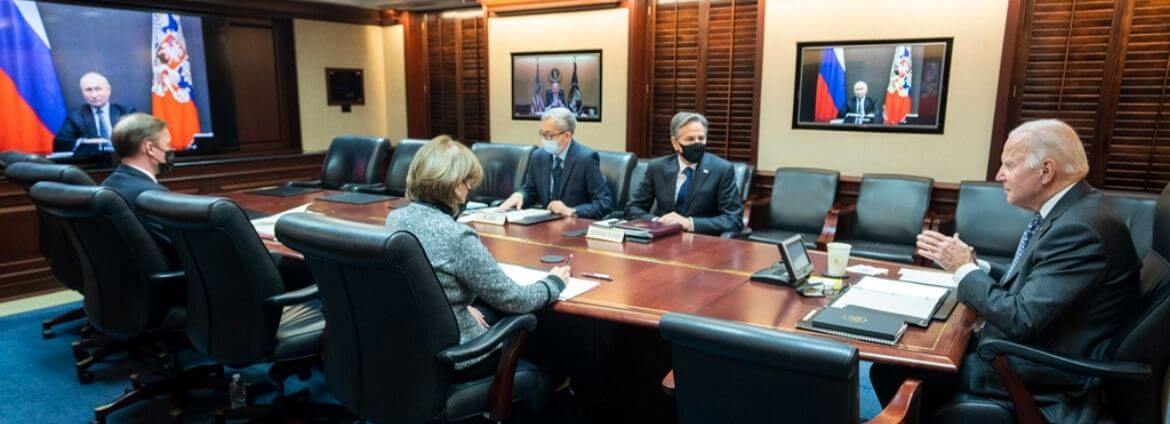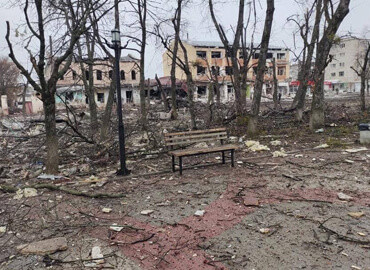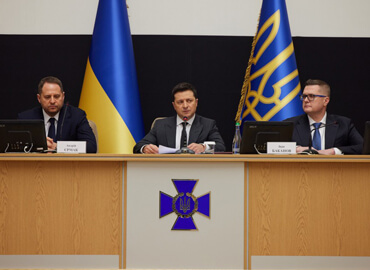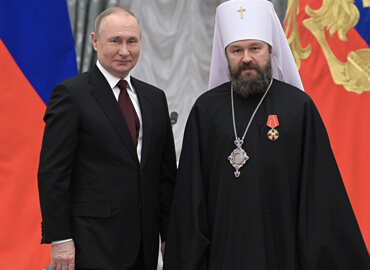Biden’s second discussion with Putin was held. From the two meetings – Geneva (July 2021) and this latest one (December 2021) – a straight line emerges through two points. Although the results of these meetings are still minimal, Biden with an experienced hand announced the «spirit of Geneva»; that is, he made it clear that he is creating a new strategic track. Unlike Obama, he is not proposing a «reset» and unlike Trump, he is not suggesting that it is possible to «come to an understanding» with Putin. The new track is announced like a dialog box in the field of political containment.
The December 7 conversation has been well covered by the media and political actors from all sides. The Kremlin publicly noted its refusal to negotiate with the Zelensky administration (in an article by Dmitry Medvedev) and Putin and Patrushev clearly joined Lukashenko in the migration crisis, shifting responsibility from Minsk to Western countries. The degree of the «war with the West» jumped sharply in Moscow and Minsk around the migration crisis. On the eve of the conversation, the American media first drew attention to the Russian military group near the Russian-Ukrainian border and then launched a scenario of a possible Kremlin attack on Ukraine in the global media. More than 30 world media outlets have visualized this threat with the help of various infographics, clearly showing the military capabilities of the Kremlin. The migration crisis, inspired by Lukashenko, almost flew off the radar. It has merged in some respects into the larger picture of escalation in Eastern Europe.
As a result, the conversation between Biden and Putin focused on de-escalation. The rest of the conversation in many media outlets sounded in the headlines: «Biden supported Ukraine. He told Putin that in the event of a military escalation, the West’s response will be tough.» Biden’s strategy is easy to read: as he told Putin in Geneva, the main goal is for the Kremlin to determine for itself whether it wants to move on with «this» world or with «that» (China).
Everything else, from Biden’s point of view, is located a step below this and on all other issues there is clarity. Ukraine joining NATO? Yes, it is possible. This is a choice for the Ukrainian people. The Kremlin’s red lines? No, they don’t exist. But at the same time, Biden, as far as can be seen within the framework of this policy of containment, leaves the Kremlin a corridor along which it can move if it wants towards a profitable result. But even if the Kremlin does not take major steps, it needs to maintain a «gate» at the expense of small negotiation tracks. And at the same time, it needs to slowly continue to «peel back the onion» at the expense of sanctions and energy policy, creating a catastrophic gap in technological development.
And the main question for the Kremlin is highlighted by the Summit for Democracy: here, along these paths, there will be a renewal of the global political architecture of the 21st century. Do you want to take part? If not, okay. Then you will remain with your seat in the UN Security Council, with the right of veto, and with your frustrations regarding regional hegemony in the previous century. At the same time, the construction of the Summit for Democracy is such that it is enough to have a regime like Lukashenko’s 2015-2020 format – «dynamic autocracy» – and you will jump on the bandwagon. Therefore, the doors are open both for Putin (if he stopped fruitlessly «re-creating the USSR»), and even for Lukashenko (if he were able to move towards «normalization»).
Biden is not an idealist. Many asked why he did not raise the issue of human rights in the conversation, and why he did not demand the release of Navalny, and why he did not bring down «hellish sanctions» right now. The answer is simple and easy to read. All that is required from Putin – and from Lukashenko, who is fastened to him with prison handcuffs – is to stop doing «external evil»; that is, to stop playing at global destabilization. And inside you can live as you want, or at least revel in your chains. That is why we see at the Summit for Democracy, for example, Pakistan and the Philippines, whose regimes are no less «bound» than Putin’s, and there is only one question for Putin: do you want to be in the football league along with Iran and Saudi Arabia? Will you play there? Well, okay. Free will is freedom of choice. Though we asked little of you.
Kremlin’s response
In response to all this, Putin sent out a response following the meeting. The response is hysterical in tone, and like many of the Kremlin’s latest political gestures – specifically, the publication of Lavrov’s correspondence with the German and French Foreign Ministries – it is directed into outer space, and the preamble is deliberately offensive to an imagined interlocutor. The Kremlin demands the disavowal of the Bucharest Memorandum, demands that NATO give a written commitment not to «expand toward the East,» and proposes negotiations on the disengagement of exercises, warships, and strike military groups from the Russia-NATO contact line. It is clear from the communique that the Kremlin, instead of a reasonable dialogue, is planning to roll out to Biden a big document (a «comprehensive proposal») to strengthen «strategic stability.» It follows from this response that the Kremlin will not withdraw its strike group from the border with Ukraine now and will continue to blackmail Poland and the Baltic countries by expanding military cooperation with Belarus. And a new stage of the gas and ideological war lies ahead of us. While Putin has repeatedly stated that gas commitments are separate from politics, times have changed. In 2021, the topic of «gas blackmail» – and not only in relation to Ukraine, but in relation to Europe as a whole – made headlines in the Kremlin media. Lukashenko, running ahead of Putin, threatened to cut off the gas and Putin pulled back. But everyone understands that the Kremlin has few tools to continue the escalation, they are all in visible, and gas is one of them. Even if you do not want to use it you have to.
In Ukraine, public commentators are now paying much attention to the question of whether Biden will betray them. But this is not the problem at all, but rather in the position of several European countries, which have strategically vacillated in the escalating situation. The question is not how the Biden-Putin dialogue will proceed further, but whether Putin will succeed in weakening the unity of Europe at the expense of the position of supporters of a compromise with the Kremlin’s pretenses. For a long time, they said «America is leaving.» That is what they said under Obama. But during his time in office the Kremlin did not believe it. That is what they also said under Trump, and then the Kremlin experts adapted to the situation and began to discuss how «if America is leaving, how the world will be arranged after it leaves.» The word «leaving» has become a mantra, an inertial meme. The Kremlin has taken root in this mantra, and the withdrawal from Afghanistan even resulted in short-term euphoria in Moscow. However, the euphoria rested on a misunderstanding of reality. What does «leaving» mean? America «leaves» somewhere and «arrives» somewhere else. The U.S. «left» one place, but they «came» to Eastern Europe. And now American javelins and destroyers are visible directly from the battlements of the Kremlin wall. This is the situation now. The period of 2014-2020 is over and a new era is beginning in the evolution of Putin’s political system – for Ukraine, for Belarus, and for the entire region – which includes the countries of the «intermarium» that are already members of NATO. Eastern Europe is entering a new strategic situation.
Alexander Morozov, researcher in the Faculty of Philosophy at Charles University, iSANS expert.
This article was prepared by iSANS specially for Reform.by.
Материал доступен на русском языке: Что будет вместо войны в Восточной Европе











